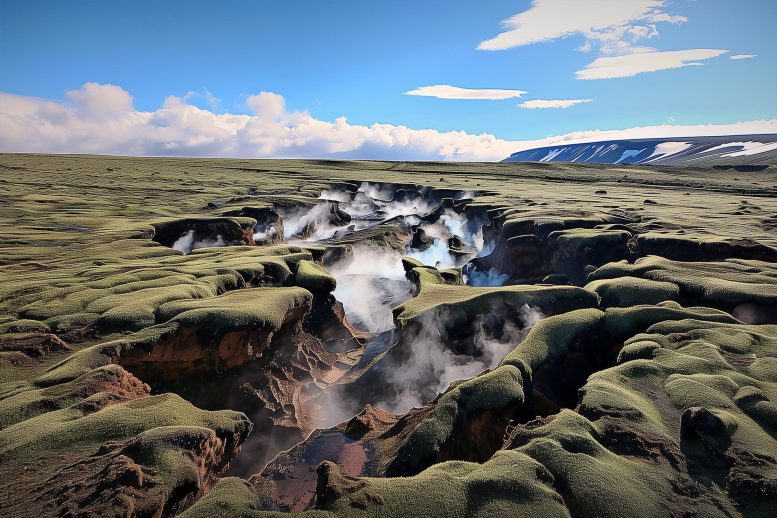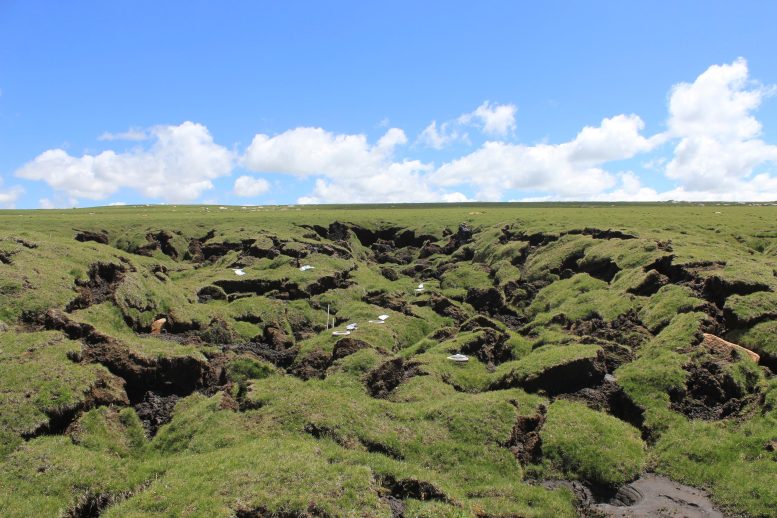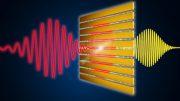
A new study highlights that collapsed permafrost areas emit far more CO2 in response to warming than areas with intact permafrost, raising concerns about accelerated climate change impacts. Credit: SciTechDaily.com
Research indicates that permafrost-collapsed areas emit significantly more CO2 in response to climate warming than in non-collapsed areas, with implications for global carbon cycle dynamics.
Scientists have discovered that soil carbon dioxide (CO2) emissions are more sensitive to climate warming in areas where permafrost has collapsed compared to areas where it remains intact. This conclusion comes from a recent study published in Nature Geoscience. By conducting field warming experiments and laboratory incubations of soils from extensive sampling, the research provides fresh insights about permafrost carbon-climate feedback in the face of rising global temperatures.
Effects of Permafrost Thaw on Carbon Emissions
In regions of high latitude and altitude, warmer temperatures have significantly accelerated the thawing of permafrost. Approximately 20% of the northern permafrost region undergoes abrupt thawing, known as thermokarst, but this region contains about half of all subterranean organic carbon. The sudden thaw can dramatically alter the landscape and the physical and biological properties of the soil, thereby heavily influencing the carbon cycle within ecosystems.
Study Details and Methodology
Previous studies have failed to address whether the impacts of warming on soil CO2 flux differ between thermokarst and non-thermokarst areas. To fill this knowledge gap, Professor Yuanhe Yang and his team from the Institute of Botany of the Chinese Academy of Sciences have explored how the formation of thermokarst alters the soil’s response to climate warming.
Their research used various methodologies, including a well-replicated warming experiment conducted in both thermokarst and non-thermokarst areas. They discovered that thermokarst areas exhibit a warming-induced CO2 release rate that is approximately 5.5 times higher than that in non-thermokarst areas.
Findings on CO2 Flux Response to Warming
The team analyzed over 30 potential factors that could affect the increased CO2 release due to warming. They concluded that the heightened response in thermokarst areas is primarily due to poorer soil substrate quality and a higher presence of microbial genes involved in decomposing organic carbon.
Additional experiments incubating soils from six thermokarst-affected sites along a 550-km permafrost transect also confirmed that thermokarst formation significantly raises the temperature sensitivity of CO2 release, underscoring a robust response of these soils to climate warming.
Global Implications and Future Projections
Professor Yang emphasized the broad significance of their findings, stating, “As a preliminary exploration of its global importance, extrapolating the warming response of soil CO2 flux to all upland thermokarst regions in the Northern Hemisphere, there could be an additional 0.4 Pg C year-1 of soil carbon release, which is about a quarter of the projected permafrost soil carbon losses by the end of the 21st century.”
This research not only sheds light on the dynamic responses of permafrost soils to warming but also aids in refining projections regarding future permafrost carbon-climate feedback mechanisms.
Reference: “Enhanced response of soil respiration to experimental warming upon thermokarst formation” by Guanqin Wang, Yunfeng Peng, Leiyi Chen, Benjamin W. Abbott, Philippe Ciais, Luyao Kang, Yang Liu, Qinlu Li, Josep Peñuelas, Shuqi Qin, Pete Smith, Yutong Song, Jens Strauss, Jun Wang, Bin Wei, Jianchun Yu, Dianye Zhang and Yuanhe Yang, 30 April 2024, Nature Geoscience.
DOI: 10.1038/s41561-024-01440-2










OK!